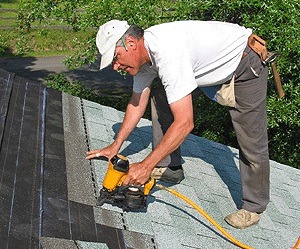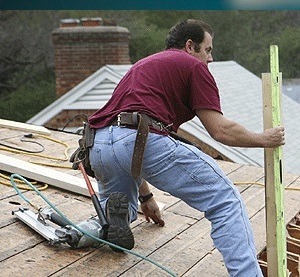Some home repairs you can do yourself; others require a professional. When it comes to roof leaks, calling a licensed roofing contractor is your best course of action. Roofs are the first line of defense homes and other buildings have against weather and damage. They keep out rain and snow, help regulate home temperature by insulating against hot and cold, and provide solid protection for everything below. So when leaks happen, fast action is required to maintain the integrity of the roof and the home under it.
Roof repairs run the gamut from minor leak repairs to major damage restoration, so costs vary. According to one online roofing calculator, you can expect minor roof repairs to cost $150 to $400, moderate repairs to cost $400 to $1,000, and major repairs to run $1,000 to $3,000 and beyond.
Keep in mind, though, that your home is an investment, and you’ll want to hire only licensed, insured, quality roofing services who will provide good value for their services. Everyone wants to save money, but the best way to do that is by insisting on quality repairs by honest contractors rather than cheap roof repairs that won’t hold up and can compromise your safety and the integrity of your home.
| Average Expected Repair Costs for Roof Leaks | |
| National average cost for roof repairs | |
| Simple/minor repairs | |
| Moderate repairs | |
| Major repairs | |
| Composite roofing | $450-2,000 |
| Shingle roof repairs | $500-3,000 |
| Metal roof repairs | $500-1,000 |
| Wood shake roof repairs | $750-3,000 |
| Stone and slate roofing | $500-1,500 |
| Flat roof repairs | $300-1,000 |
| Repair/replacement of roof flashing | $400-800+ |
| Chimney repairs | $800+ |
| Skylight reflashing | $1,500 |
| Roof vent gasket repair/replacement | $50-150 |
Causes of Roof Leaks
Most roof leaks are caused by damage or age. Hail, wind, falling tree branches and other physical damage can cause shingles to lift up or fall off. Time can cause shingles to curl, separate at the seams, lift up, and shift; roof flashing around chimneys and valleys can flatten with age or damage, and gaskets around skylights and vents can crack due to weather extremes.
Improper installation can be another reason roofs leak. If contractors don’t use the proper fasteners, tools, methods, or care, shingles and seams can pop or lift up, allowing in water and creating permanent damage.
In many of these cases, a full roof replacement isn’t necessary. Most shingle roofs are expected to last 20 to 30 years, and metal and stone roofs can last 100 years or more. So if your roof has more life left in it, repair can be the smartest way to go.
Only a licensed contractor performing a thorough roof inspection can tell you which way is best, though. Some newer-looking roofs can have structural problems that can only be fixed by replacement, while other older roofs may have a few years of life left if repaired the right way.
In any case, it’s always important to address roof leaks immediately, as even small amounts of occasional water can cause major structural problems like rotted roof beams, wall and ceiling damage, mold and mildew growth, electrical fire hazards, and even irreparable foundation damage. Top Ten roofers listed at The Prime Buyer’s Report are a good resource for roofing inspections, repairs, and replacement.
The Type of Roofing Impacts the Cost
Most roofs are shingle roofs, and those tend to be the cheapest to repair, especially if leaks are caught early. Shingle roof repairs that require only leak sealing, shingle replacement, and shingle sealing in a small area can cost as little as $150. More major repairs that require removing shingles, repairing damaged boards under the shingles, and replacing and sealing shingles in a larger section of the roof can cost up to $3,000. A major source of roof leaks are broken and missing shingles, so regularly inspect your roof from the ground, looking for visible signs of problems like missing or shifted shingles, curling shingles, and shingles that suddenly appear different than the rest of the roof.
Wood shake roofs are more expensive to replace, especially if your contractor is taking steps to mix old and new shakes to avoid the appearance of an obvious repair. Most wood shake roof repairs cost around $750 for minor repairs, but this will vary according to the type of shakes, the area needing repair, and the age of your current shakes.
Composite roofing tends to be lighter weight than other roofing shingles, so it’s prone to damage or removal by high winds that get under the shingles and tear or lift them up. Composite roofing is less expensive to fix, generally around $450 for an average repair.
Metal roof repairs cost between $500 and $1,000 to repair seam and fastener problems or to repair installation errors.
Flat roofs can cost up to $1,000 to fix sealing problems or prevent water pooling issues.
Stone roofs and slate tiles are more expensive to repair. Average repairs range between $500 and $1,500 and usually are needed to address cracked tiles, installation mistakes, or misplaced tiles that can allow water underneath.
Repairs to Other Roof Components

Flashing is a thin metal placed at areas where roofing bumps up against a wall, dormer window, chimney, vent, skylight, or valley in the roof where water may collect or seep into vulnerable areas of the roof. It’s meant to divert water and keep it flowing toward gutters or off of the roof, but sometimes it begins to fail. This can cause leaks at these points of entry. Flashing that’s damaged or leaking will need to be replaced and the shingles around it will also need to be replaced and sealed. Average-length pieces of flashing generally cost $400 to replace, but longer pieces and complex installations around chimneys and dormers can cost $800 or more.
Chimney repairs and repairs around chimney flashing often cost $500 and more. If the chimney is old, crumbling, or has serious damage, it may need to be replaced or capped, and that can cost considerably more—into the thousands of dollars.
Skylights, solar tubes, sun tunnels, and moonlights can leak if the flashing around them is damaged or incorrectly installed, and gaskets and seals around the fixtures themselves can become old and damaged. Some leaks can be easily repaired by replacing gaskets or sealing with silicone caulking or specially made solar seals. Reflashing around skylights usually costs around $1,500 per skylight. In many cases when older skylights are involved, replacing the entire skylight is the best option and should be done when the roof is reshingled or replaced to keep the cost as low as possible.
Vents in the roof that lead to bathroom and attic fans, dryer vents, or other air vents in your home can age over time. For many, this can result in cracked booting at the base of the vent. This booting is a gasket that seals the vent to the roof, and weather and time can create cracks that let in water. Replacement booting is usually an inexpensive fix if caught early, and can cost as little as $50 for a professional to replace. If one vent gasket is cracked and leaking, it’s smart to have your contractor replace all the gaskets on your roof at the same time.
Factors That Can Increase the Cost of Roof Repairs
- Age and condition of the roof: Older roofs and roofs that are in bad shape may cost more to repair. Contractors may see more areas that need repairs, repairs may be more extensive, or it may take longer to repair old roofs. In some cases, flashing or underlayment may need to be replaced or repaired.
- Area of the leak: If the leak is in a hard-to-reach area or near a wall or dormer, costs may go up. That’s because these repairs can take longer and require more detailed repairs or repairs to areas around the leak.
- Type of roof: Asphalt shingles are usually the cheapest roofs to repair, while metal roofing and natural slate can be the most expensive. However, more expensive materials tend to last longer, so your investment may cost less over time.
- Roof pitch: Flat roofs and those with very little pitch are the most expensive to repair because repairs tend to be more complex. Very steep roofs can also be hard to repair. If your home has a moderate pitched roof, your repair will likely be less expensive because the roof will be easier to access and work on.
- Amount of debris: Most roofers charge for removal of debris that is generated when roofs are removed or repaired. Small repairs and patch jobs don’t require much tear-out, so removal and disposal fees will be lower. Large repairs and massive damaged areas that require replacement are more expensive to repair because of removal, hauling, and disposal fees.
- Permitting and extra fees: Repairs that require permits usually incur an extra cost. While your roofer will likely be the one obtaining the permit, they’ll pass the fees on to you.

